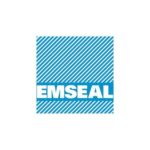24-year Run at Guggenheim–Colorseal a Permanent Exhibit at Historic Landmark Museum
New York City, NY—Twenty-four years later Colorseal installed between a neighboring building and the 10-story museum office addition completed in 1992 is still as resilient and watertight as the day it was put in.A personal trip to NYC to visit the Solomon R. Guggenheim Museum for the first time to admire this historic landmark and the art on display also provided an opportunity the inspect the Colorseal installed at the time of the addition.
The nine-story addition designed by Gwathmey Siegal and based on a background structure proposed by Wright in 1951, provides 51,000 square feet of space for administrative offices and four floors of galleries capable of accommodating large-scale art.
Where’s the Colorseal? The joint is between the limestone-faced addition on the left of Frank Lloyd Wrights iconic original museum and the darker neighboring brick building to its left.
Structural expansion joints are design elements necessary for accommodating movements within and between buildings. These movements are caused by thermal changes, wind, dynamic loading and unloading, and seismic forces. For most designers expansion joints are a necessary, ugly evil. But expansion joints go mostly unseen by the casual pedestrian. And when cleverly positioned, as in this case revealed slightly from the building faces, the joint becomes simply a part of a shadow line that reflects similar design elements across the buildings facade.
From the ten feet away the joint remains essentially a shadowline although the “Limestone” colored silicone, chosen from 26 standard colors, provides color integration with the limestone facade when viewed from close-up.
Viewed from close up (BELOW: just 10-inches from the joint), the Colorseal is seen to be firmly locked to both substrates.
To thumb pressure, the material is resilient and responsive. The stored-strain energy of pre-compression remains very evident and there are no signs that the material is degraded or suffering compression set that might constrain its ongoing performance.
Colorseal features non-invasive anchoring. This means it is not anchored to the substrates with metal pins, screws, embeds or hard connections of any kind. This translates into numerous benefits.
Neither the neighboring owner nor the museum had to worry about drilling into the existing brick of the existing structure. Nor did the museum have to be concerned with drilling into their new limestone facade to anchor the expansion joint.
The absence of anchors means there are no thermal breaks in joint system that could significantly impact the R-value of the joint and subsequently the wall itself. And, the absence of aluminum rails typical of alternative “strip seal” joints further improves R-value while allowing the pre compressed foam to expand into and fill voids at mortar joints.
After 20 years of service, this Colorseal is watertight, blocks sounds from the city streets, insulates, is non-invasively anchored and aesthetically coordinated into the structures it bridges.
It is of course better to start out at new construction with EMSEAL as the basis of design for joint systems but retrofit is routine, practical and lasting as well.
Lasting expansion joint solutions in mixed-use, retail, office, sports, assembly, convention, educational, performing arts venues and yes, museums as well, is a central focus of EMSEAL’s.
The company’s unique approach to expansion joint treatment combines innovative materials technologies with a fresh look at the roles of owners, designers, general contractors, manufacturers and subcontractors, in achieving trouble-free expansion joints.
The approach is grounded in an integrated, collaborative process centered on joint treatment that requires all of these parties to think, design, detail, specify, construct, fabricate, and install three-dimensional solutions.







